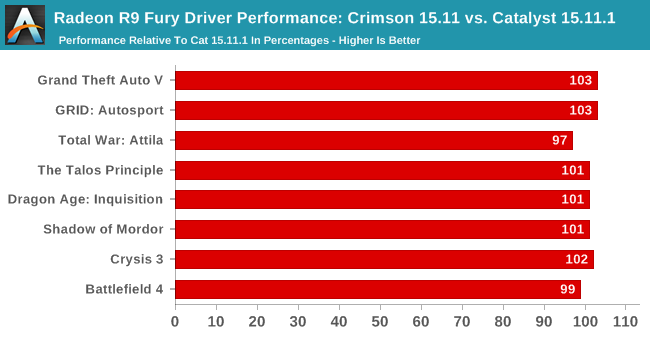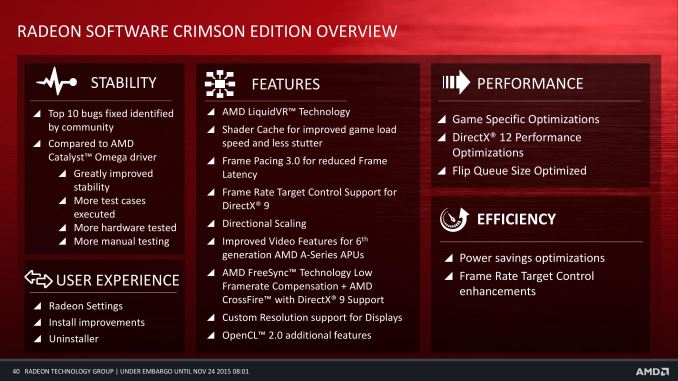AMD's Radeon Software Crimson Driver Released: New Features & A New Look
by Ryan Smith & Daniel Williams on November 24, 2015 8:00 AM ESTCrimson Performance
Last but certainly not least, let’s talk about performance improvements. Like the Omega driver before it, Crimson comes with a collection of performance improvements from AMD’s new driver branch. To preface this with caution, I don’t think anyone should be expecting massive system-wide performance gains – that’s all low-hanging fruit AMD picked long ago – but there’s plenty of room for some lesser optimizations along with game-specific optimizations.
AMD’s own numbers point to game-specific improvements of up to 20%, though it should be noted that AMD’s best-case numbers are on unreleased/beta games that have yet to be well-optimized in the first place. Otherwise AMD’s own numbers are far more tame, listing recently released games with gains between three and five percent.
To take a quick look at general performance, we went ahead and ran our GPU benchmark suite at 2560x1440 on our Radeon R9 Fury (vanilla), comparing the previous Catalyst 15.11.1 beta to the new Radeon Software Crimson 15.11 beta. The Fury and its underlying Fiji GPU is the newest product out of AMD, so it offers AMD the best opportunity to unlock any remaining performance in the architecture.

Overall the average performance gain at 2560x1440 is just 1%. There are a couple of instances where there are small-but-consistent performance gains – Grand Theft Auto V and Grid: Autosport stand out here – but otherwise the performance in our other games is within the margin of error, plus or minus. Not that we were expecting anything different as this never was pitched as a golden driver, but this does make it clear that more significant performance gains are going be on a per-game basis.
Final Thoughts
Wrapping things up, AMD’s development structure in the past year and going forward is one that has both been beneficial to the company and has brought with it its own drawbacks. By focusing feature releases around the end of the year driver, AMD is able to cut down on what parts of the driver they change (and thereby can possibly break) at other times of the year, and try to knock out all of their feature-related bugs at once. At the same time it makes the annual driver release a significant event, as AMD releases a number of new features all at once. However on the other hand this means that AMD has few features launching any other time of the year, which can make it look like they’re not heavily invested in feature development at those points. Then of course there’s the WHQL element, where for multiple reasons AMD hasn’t issued very many WHQL releases this year, and is something they’re seeking to change in 2016.
Looking under the hood there’s no single feature that’s going to blow every Radeon user away at once, but overall there are a number of neat features here that should be welcomed by various user groups. The Freesync Low Framerate Compensation changes should be of particular interest to Freesync users, while shader caching will improve shader loading performance across the board. Otherwise smaller fixes like the DirectX 9 improvements to CrossFire frame pacing, CrossFire Freesync, and framerate target control should be welcome news to APU and dual graphics users.
Meanwhile AMD’s radical overhaul of their control panel via the new Radeon Settings application will be quickly noticed by everyone. Though there’s plenty of room for interpretation on style and just how a good control panel is laid out, AMD has clearly put a lot of effort into cleaning up the layout of their control panel and it shows, as important options are no longer buried under multiple layers of menu trees. And on the performance front Radeon Settings is faster than Catalyst Control Center even on fast machines, and though we haven’t spent much time on covering it, AMD has also managed to speed up the installation process while they were at it. So all-told the Crimson release has something for everyone.
Ultimately I hesitate to ascribe too much of this to the Radeon Technologies Group too soon – this project has clearly been in the works longer than 3 months – but at the same time this is the RTG making their mark. It’s a new direction for AMD’s graphics group and a new look to match. And if the RTG can meet their stability, performance, and release goals going forward with the new Crimson driver, then they should be able to make 2016 a good year for the Radeon user base.


















146 Comments
View All Comments
Jaksi - Wednesday, November 25, 2015 - link
"To preface this with caution, I don’t think anyone should be expecting massive system-wide performance gains..."I expect more from a site such as Anandtech.
Tests from OC3D and WCCFTECH show a 2-20% performance improvement, as well as a MASSIVE improvement of the minimum frame rate.
Are you seriously going to let this article stand as is ? It's a disgraceas it is right now, in my opinion. If you choose to write something, at least get it right.
ViRGE - Thursday, November 26, 2015 - link
Haven't read OC3D, but WCCFTech has the 380X (Tonga) beating the 290X (Hawaii). That alone should raise some massive red flags in their testing.Mugur - Thursday, November 26, 2015 - link
Yes, there are some big differences in benches compared to Anand's. Hard to say if it's only the test bed (Skylake vs. Haswell, etc) or other things...Sirk77 - Wednesday, November 25, 2015 - link
Article was great. The driver... Not so good. Well, at least for me. It will not install. At first it seemed like it as getting hung up on the C++ redis install. I downloaded the 2012 C++ redis and installed it without issue. However, I am still unable to install the new Crimson drivers.This is on a relatively new Windows 10 install too. The first driver I ever installed was 15.7.1 and the newest before Crimson was 15.11.1.
I'm going to take another crack at it tonight, but I don't have high hopes. Bad form AMD. I should not be having these issues in the year 2015. Reminds of the days of installing 3DFX, or especially Nvidia, drivers in Windows98.
Sirk77 - Wednesday, November 25, 2015 - link
Typo... I meant 2013 C++ redis.erple2 - Thursday, November 26, 2015 - link
Funny, I was excited that and was starting to use redis, but then realized that you were talking about something far less interesting.http://redis.io
Sirk77 - Friday, December 4, 2015 - link
Broke my OS. Had to re-install. After the install was complete the drivers installed; however, they've been buggy. I put on the latest drivers to resolve the fan issue and ran into the same issue again.Gets to 2% and stalls. I'm running the 15.11.1 Catalyst drivers again. No issues with those.
PatrThom - Wednesday, November 25, 2015 - link
So the big question is...with HD5xxx and HD6xxx cards going Legacy, what benefit does the Crimson update provide over the 15.7.1 WHQL? Is there a chance we can find out how much of a benefit Crimson provides to the NON-GCN-based cards?Dalamar6 - Wednesday, November 25, 2015 - link
Just installed new drivers, laughed my ass off when I realized it's literally a frontend for the old catalyst control center (which now loads slow af and is called Radeon Additional Settings). RIP amd, your suck has reached a new height.Oxford Guy - Thursday, November 26, 2015 - link
Like Windows 10 is a new front-end for Windows 7?